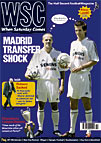 It was the end of football as we knew it. With everything set to change with the introduction of the Premiership the following season, 1991-92 saw us wave goodbye to the days when Division One meant exactly that. Philip Cornwall reports
It was the end of football as we knew it. With everything set to change with the introduction of the Premiership the following season, 1991-92 saw us wave goodbye to the days when Division One meant exactly that. Philip Cornwall reports
The long-term significance
Played under the shadow of the FA’s Blueprint for Football that spawned the Premiership, this was the final season that the Football League champions were the champions of England, that Division One was the first division. As it has turned out, it was the last time so far that the champions of England had an English manager. It was also a season of transition: neither of 1991’s top two seriously challenged for the title.
Story of the season
Proof that this was a different era comes with the identity of the champions’ top scorer: Lee Chapman. But Leeds’ great strength was the midfield – Batty, Strachan, Speed, McAllister.
George Graham’s Arsenal, beaten just once the previous season, lost twice in August, while after only one season outside the top two since 1974, Liverpool slumped to sixth under Graeme Souness. Liverpool’s era was over, Manchester United’s starting – but they still missed out on the title.
For months, Howard Wilkinson’s side kept somewhat grimly in touch with or even ahead of the other United, largely because Leeds had played more games. A 4-0 April defeat at Maine Road seemed sure to end Leeds’ chances – a point behind rivals who had two games in hand – but it all went wrong from Easter for Alex Ferguson. A draw at doomed Luton was followed by three straight defeats – at home by Forest, at also doomed West Ham and at Liverpool – the last making Leeds unassailable.
Luck – a penalty gift from the referee at Coventry, an own goal at Sheffield United – played its part, as did a late injection of Gallic flair. But they won the title by four points and with a game to spare.
For the record books
Leading scorer: Ian Wright (five for Palace, 24 for Arsenal) 29 – now a “broadcaster”.
Highest attendance: Manchester United v Nottingham Forest, 47,576. Lowest: Wimbledon v Sheffield United, 3,121.
Biggest win: Arsenal beat Sheffield Wednesday 7-1 – but still finished fourth, three points behind Trevor Francis’s side in the young manager’s promising first season.
Same place today
All that has changed for Alex Ferguson is the addition of his “Sir”. Arsenal, Aston Villa, Chelsea, Everton, Liverpool, Southampton and Tottenham have also enjoyed continuous runs in the top flight.
Moved furthest away
Notts County sank to the basement by 1997 and are back there now. Sheffield Wednesday, Luton and Oldham are only slightly better off, along with the mutated Dons.
Went onto greater things
Eric Cantona – France’s talented misfit wound up in Leeds after a move to Sheffield Wednesday (right) collapsed when a trial fell foul of the weather.
Ray Parlour – gave away a penalty at Anfield in the first of his 339 League appearances for Arsenal.
Rob Jones – played for Crewe on September 28; played for Liverpool at Old Trafford on October 6; England debut against France on February 19.
Alan Shearer – finished his spell at Southampton – where he often played in midfield – with 23 goals in 118 league games
Disappearing from view
Gary Lineker – off to Japan from Tottenham after Euro 92, via a brief spot on TV at the Barcelona Olympics.
Brian Clough – could have retired gracefully with another top-half finish; Nottingham Forest went down and he went out a year later instead.
Frank McAvennie – slipped out of a top-flight starting line-up and into lurid legend with a last-day hat-trick for West Ham against Forest.
Division Four – as a byproduct of the demise of the real Division One, after 34 years’ service.
From WSC 212 October 2004. What was happening this month